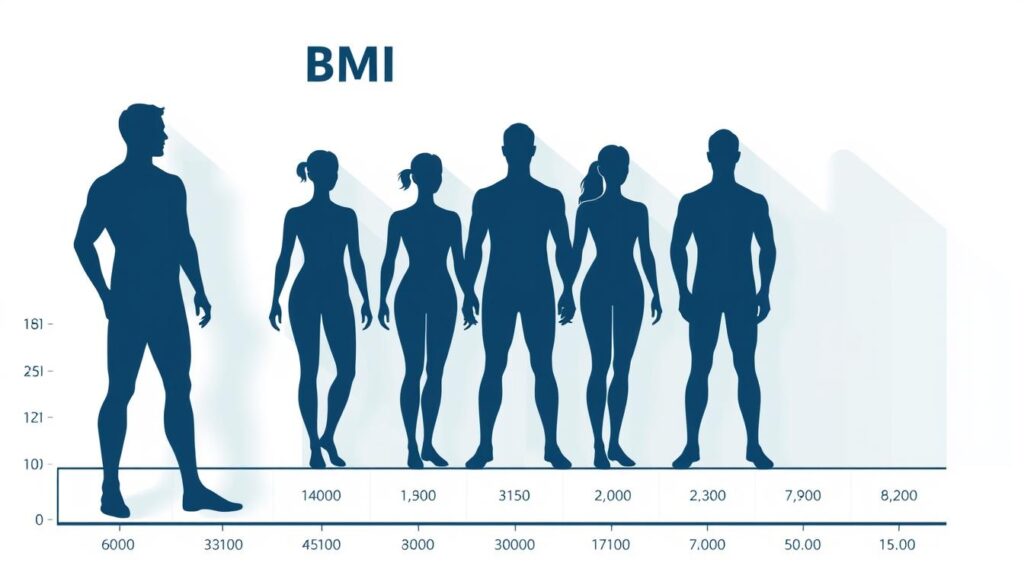Many people want to improve their body shape but worry about losing muscle. They ask, how to reduce body fat without losing muscle. It’s a common concern because losing weight often means losing both fat and muscle.
Studies show that making dietary changes, focusing on specific exercises, and changing your lifestyle can help. This way, you can have a lower BMI without losing muscle. Keeping a balance is key for good health and fitness.
We will look into how to reduce BMI while keeping muscle. We’ll talk about diet, exercise, and lifestyle changes that help with this goal.
Key Takeaways
- Understand the importance of maintaining muscle mass while lowering BMI.
- Learn dietary strategies that support muscle preservation during weight loss.
- Discover effective exercise routines for building muscle while reducing fat.
- Explore lifestyle changes that contribute to a healthier body composition.
- Find out how to monitor progress and adjust your strategy as needed.
Understanding BMI and Its Importance
Checking our BMI is key to spotting health risks. BMI tells us if our weight is right for our height. It’s a basic check for our health and fitness.
What is BMI?
BMI, or Body Mass Index, uses height and weight to classify our weight status. It’s calculated by dividing weight in kilograms by height in meters squared (kg/m^2). This shows if our weight is healthy for our height.

Why BMI Matters for Our Health
BMI is important because it shows health risks tied to weight. A high BMI can mean heart disease, diabetes, and cancer risks. A low BMI might mean malnutrition or weak bones. Knowing our BMI helps us avoid these problems and stay healthy.
How Muscle Mass Affects BMI
Muscle mass is key to our health and can change our BMI. BMI doesn’t tell the difference between muscle and fat. So, athletes with lots of muscle might have a high BMI but not be overweight.
To lower BMI without losing muscle, we need to focus on BMI reduction without muscle loss. We should aim for healthy body composition tips that help us lose fat but keep muscle. This way, we not only improve our BMI but also our overall health.
Strategies to Lower BMI Safely
To lower BMI without losing muscle, we need a smart plan. This plan should include a healthy diet and regular exercise. Both are key to reaching our goal.
The Role of Diet in Reducing BMI
A healthy diet is key for keeping muscle while lowering BMI. We should eat balanced nutrients that help our muscles.
We need to eat a variety of foods. Foods rich in protein, healthy fats, and complex carbohydrates are important. They help keep our muscles strong and healthy.
Importance of Balanced Nutrients
Balanced nutrients are vital for our health and muscle. Our diet must have enough protein to support our muscles.
- Protein-rich foods help in maintaining and repairing muscle tissue.
- Complex carbohydrates provide energy for our workouts and daily activities.
- Healthy fats support hormone production and overall well-being.
Incorporating Physical Activity
Regular exercise is crucial for lowering BMI while keeping muscle. We should mix resistance training and cardio exercises into our routine.
Resistance training builds and keeps muscle mass. Cardio exercises help with fat loss and heart health.
Effective Workouts to Preserve Muscle
To keep muscle while lowering BMI, we need to choose our workouts wisely. The right exercise is as crucial as the right diet. This ensures we don’t lose muscle mass.
For muscle preservation, we should mix strength training, high-intensity interval training (HIIT), and enough rest. Each part is vital for keeping muscle while cutting down body fat.
Strength Training Essentials
Strength training is key to keeping muscle. It uses resistance to make muscles grow and get stronger. Key exercises include squats, deadlifts, and bench presses, which work many muscles at once.
A good strength training plan should have:
- Compound exercises that work many muscles
- A mix of heavy weights for low reps and lighter weights for high reps
- Progressive overload to keep muscles challenged
High-Intensity Interval Training (HIIT)
HIIT is short, intense workouts followed by brief rests. It’s great for boosting heart health and burning fat without losing muscle.
Examples of HIIT workouts include:
- Sprinting or cycling for 30 seconds, then 30 seconds rest
- Burpees or jump squats for 20 seconds, then 40 seconds rest
HIIT sessions can last 15 to 30 minutes. It’s a quick way to get fit.
Recovery and Rest: Key to Muscle Preservation
Enough rest and recovery are essential for muscle preservation. Exercise causes muscle tears, and rest helps them repair and grow. Getting enough sleep and taking rest days are key.
A comparison of recovery strategies is shown in the table below:
| Recovery Strategy | Description | Benefits |
|---|---|---|
| Adequate Sleep | 7-9 hours of sleep per night | Muscle repair, hormonal balance |
| Rest Days | 1-2 days off from intense exercise per week | Prevents overtraining, allows muscle recovery |
| Nutrition | Adequate protein and carbohydrate intake | Supports muscle repair and energy replenishment |

By adding strength training, HIIT, and enough rest to our routine, we can keep muscle while lowering BMI. It’s about finding a balance that fits our lifestyle and goals.
Nutritional Approaches for Muscle Retention
A good nutrition plan is key to keeping muscle mass while lowering BMI. It’s important to lose fat, not muscle, when we aim to reduce our BMI. Nutrition is a big part of this.
Protein: Our Best Friend for Muscle
Protein is essential for keeping and building muscle. When we’re on a calorie deficit diet, our body might use muscle protein for energy if we don’t eat enough. So, it’s important to eat enough protein. Choose high-quality protein sources like lean meats, fish, eggs, dairy, and plant-based options like legumes and tofu.
- Include protein-rich foods in every meal.
- Aim for a daily protein intake of at least 1.6 grams per kilogram of body weight.
- Consider supplements like protein powder if you’re having trouble getting enough protein from whole foods.
Healthy Fats and Carbohydrates
While protein is key for muscle retention, healthy fats and carbohydrates are also important. Healthy fats, found in foods like nuts, seeds, avocados, and olive oil, support hormone production and overall health. Carbohydrates, like whole grains, fruits, and vegetables, give us energy for workouts and daily activities.
It’s important to find a balance between these macronutrients. A diet too low in carbohydrates can make us tired and decrease workout performance, leading to muscle loss.

Meal Timing and Frequency
Meal timing and frequency also affect muscle retention. Eating protein and carbohydrates before and after workouts helps with muscle recovery and growth. Also, eating smaller meals throughout the day can help keep a positive nitrogen balance, which is important for muscle preservation.
- Eat a balanced meal with protein and carbohydrates about an hour before your workout.
- Consume a post-workout shake or meal within 30-60 minutes after your workout.
- Consider eating smaller, more frequent meals throughout the day to keep your muscles fueled.
Tracking Progress and Making Adjustments
Tracking our progress is key to adjusting our plan to build muscle while reducing BMI. Monitoring our journey helps us stay focused and make smart choices about diet and exercise.
Regular Monitoring of BMI and Muscle Mass
It’s important to regularly check our BMI and muscle mass. We can use body fat percentage, muscle mass, and BMI to track our progress. This helps us see where we need to make changes to reach our goals.
When to Seek Professional Guidance
While we can make great progress on our own, sometimes professional help is needed. If we hit a plateau or aren’t sure how to BMI reduction without muscle loss, a healthcare professional or fitness expert can offer valuable advice.
Professional guidance can create a plan that fits our unique needs and goals. For more on this, check out https://www.ncbi.nlm.nih.gov/books/NBK221839/.
Adapting Our Plan Based on Results
As we track our progress, being flexible and open to changes is crucial. This might mean adjusting our diet, changing our workout, or trying new methods to keep muscle and reduce BMI. By responding to our progress and making smart changes, we can get closer to a healthier body.
Success in reducing BMI and keeping muscle comes from consistent tracking, professional advice when needed, and being ready to adjust our plan as we go.
Infographic: Balanced Diet for Muscle Retention
To lower BMI without losing muscle, a balanced diet is key. It should include enough protein, healthy fats, and complex carbs. These are vital for keeping muscle mass.
We must eat the right foods to keep our muscles strong. Protein is essential for muscle repair and growth. Make sure to have protein in every meal.
A balanced diet helps keep muscles strong and aids in maintaining a healthy weight. This is important for lowering BMI. For more tips on losing weight and improving body composition, check out BMI weight loss strategies.
| Nutrient | Importance | Food Sources |
|---|---|---|
| Protein | Muscle repair and growth | Chicken, Fish, Eggs, Legumes |
| Healthy Fats | Energy and hormone regulation | Nuts, Seeds, Avocado, Olive Oil |
| Complex Carbohydrates | Energy for workouts and daily activities | Whole Grains, Fruits, Vegetables |
By focusing on these nutrients, we can make a diet that helps us keep muscle while lowering BMI. It’s about making smart food choices for a healthy body.
Infographic: Effective Workouts for Lowering BMI
To lower BMI without losing muscle, it’s key to add effective workouts to your routine. We’ve seen how important resistance training and High-Intensity Interval Training (HIIT) are.
By focusing on strategies to lower BMI without losing muscle, we can make a balanced fitness plan. This plan should include cardio to burn fat and strength training to keep muscle.
Seeing an effective workout routine can be really helpful. Below are some infographics showing examples of exercises and tips for adding them to your day.
By mixing these workout strategies with a balanced diet and healthy lifestyle, we can lower our BMI while keeping muscle.


